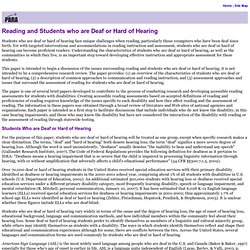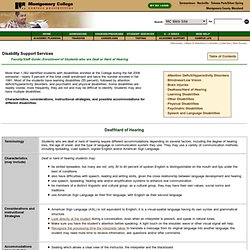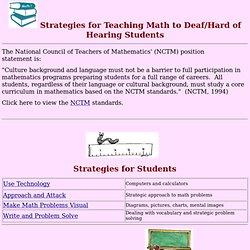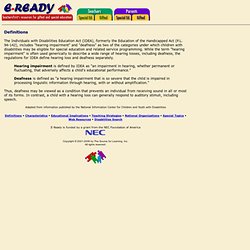

Reading and Students who are Deaf or Hard of Hearing. Students who are deaf or hard of hearing face unique challenges when reading, particularly those youngsters who have been deaf since birth.

Yet with targeted interventions and accommodations in reading instruction and assessment, students who are deaf or hard of hearing can become proficient readers. Understanding the characteristics of students who are deaf or hard of hearing, as well as the communities in which they live, is an important step toward developing effective instruction and appropriate assessment for these students. This paper is intended to begin a discussion of the issues surrounding reading and students who are deaf or hard of hearing; it is not intended to be a comprehensive research review. The paper is one of several brief papers developed to contribute to the process of conducting research and developing accessible reading assessments for students with disabilities. Marschark-II-Chap02_withAbstract. Educating Children Who Are Deaf or Hard of Hearing: Additional Learning Problems.
Deaf & Hard of Hearing - Disability Support Services - Montgomery College, MD. Students who are deaf communicate in different ways depending on several factors: amount of residual hearing, type of deafness, language skills, age deafness began, speech abilities, speechreading skills, personality, intelligence, family environment and educational background.

Some are more easily understood than others. Some use speech only or a combination of sign language, fingerspelling, speech, writing, body language and facial expression. Students who are deaf use many ways to convey an idea to other people. The key is to find out which combination of techniques works best with each student. The important thing is not how you exchange ideas or feelings, but that you communicate.
To communicate with a person who is deaf in a one-to-one situation: Get the student’s attention before speaking. Using an Interpreter: Speak clearly and in a normal tone, facing the person using the interpreter (do not face the interpreter). Adapted from: Communicating with a Student who is Deaf. _CnsmrFact_EngV3.qxd. Deafed.net Homepage. Hearing, Ear Infections, and Deafness [NIDCD Health Information] Alexander Graham Bell Association for the Deaf and Hard of Hearing. Www.tcsea.org/downlaods/helping_students.pdf. Strategies for Teaching Math to Deaf Students.
Strategies for Teaching Math to Deaf/Hard of Hearing Students The National Council of Teachers of Mathematics' (NCTM) position statement is: "Culture background and language must not be a barrier to full participation in mathematics programs preparing students for a full range of careers.

All students, regardless of their language or cultural background, must study a core curriculum in mathematics based on the NCTM standards. " (NCTM, 1994) Click here to view the NCTM standards. Strategies for Students Teacher Strategies To view some interactive mathematics lesson plans click here. Website Designed By: Suzanne Maglio Research Completed By: Erin Glading, Christina Holston, Mandy Konopka and Suzanne Maglio. Deaf teaching strategies. From January 1995 edition of P.

S. NEWS!!! By Kate Moss, TSBVI Deaf-Blind Outreach Family Training Specialist and Linda Hagood, TSBVI Deaf-Blind Outreach Education Specialist Children with deaf-blindness have unique educational needs. Although they are deaf the adaptations needed for their learning style will differ from the child who only has deafness. In order to understand what this means we can examine a variety of issues that might be addressed for three different children with disabilities in a regular preschool class: one born with a severe hearing loss, one born with visual impairment resulting in acuities of 20/600, and one born with a combined severe hearing loss and visual impairment resulting in acuities of 20/600. DH/H Eric. Definitions The Individuals with Disabilities Education Act (IDEA), formerly the Education of the Handicapped Act (P.L. 94-142), includes "hearing impairment" and "deafness" as two of the categories under which children with disabilities may be eligible for special education and related service programming.

While the term "hearing impairment" is often used generically to describe a wide range of hearing losses, including deafness, the regulations for IDEA define hearing loss and deafness separately. Hearing impairment is defined by IDEA as "an impairment in hearing, whether permanent or fluctuating, that adversely affects a child's educational performance. " Deafness is defined as "a hearing impairment that is so severe that the child is impaired in processing linguistic information through hearing, with or without amplification.
" Thus, deafness may be viewed as a condition that prevents an individual from receiving sound in all or most of its forms. VI.